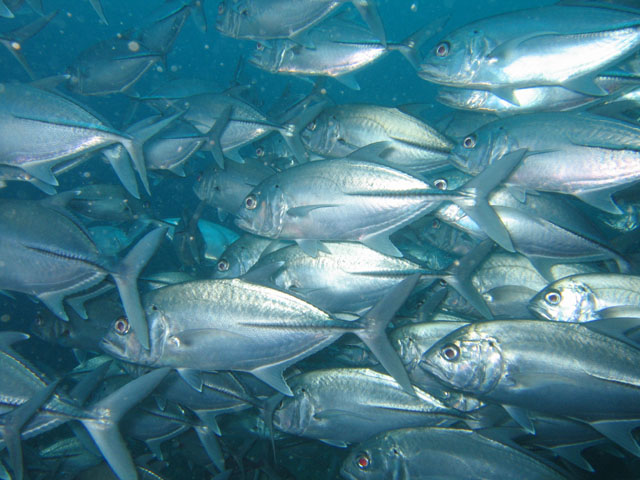
|
Caranx sexfasciatus Quoy & Gaimard, 1825 Bigeye trevally |
||
Bigeye trevally Sibo, Adlo, Ariwan, Atulay, Babadlong, Babakulan, Badlon, Bagudlong, Bakulaw, Banded cavalla, Bansikol, Barilason, Baulo, Baulo, Brunsi, Bulubukto, Dulasan, Ingatan, Istah putih, Kalapato, Karis-karis, Lambiyan, Langog, Langug, Lison, Lison, Malapondo, Malilmango, Maliputo, Mamsa, Mamsa, Mamsa, Mamsa, Manitis, Mansa, Momsa, Muslo, Nagboboguel, Orange-spotted trevally, Pagapa, Pampano, Pikat, Pinkit, Pulang buntot, Salay-salay, Saraming, Simbad, Tagiptipon, Talabkito, Talakitok, Talakitok, Talakitok, Talakitok, Talakitok, Talakitok, Talakitok, Tamarong, Tarakito, Tarakitok, Tarakitok, Trakito, Trukitok, Tungap, Ulingan, Vated, Vulong, |
||

|
|
photo by
Bailly, N. |
| Family: | Carangidae (Jacks and pompanos), subfamily: Caranginae | |||
| Max. size: | 120 cm TL (male/unsexed); max.weight: 18 kg | |||
| Environment: | reef-associated; depth range 0 - 146 m, amphidromous | |||
| Distribution: | Indo-Pacific: Red Sea and East Africa to Hawaii, north to southern Japan and the Ogasawara Islands, south to Australia and New Caledonia. Eastern Pacific: southwestern coast of Baja California Sur, Mexico and the Gulf of California to Ecuador and the Galapagos Islands (Ref. 9283). | |||
| Diagnosis: | Dorsal spines (total): 9-9; Dorsal soft rays (total): 19-22; Anal spines: 3-3; Anal soft rays: 14-17. Description: Silvery olive to iridescent blue-green dorsally, shading to silvery olive to whitish on side; small black spot on uppermost rear edge of opercle; olive to blackish second dorsal fin with white tip on anterior lobe; caudal yellowish to black (Ref. 2334, 90102). Body oblong and compressed; dorsal profile moderately convex anteriorly, ventral profile slightly convex (Ref. 90102). Breast fully scaled. LL scutes 27-36, strong and dark (Ref. 2334, 90102). Pectoral fins falcate; anal fin with 2 detached spines (Ref. 2334). Adipose eyelid well developed (Ref. 90102). | |||
| Biology: | Inhabit coastal and oceanic waters associated with reefs (Ref. 9283, 58302). Pelagic at 1-96 m (Ref. 58302). Often seen in large daytime schools; solitary at night when feeding (Ref. 90102). Adults are found in coral reefs and are mostly active at night or during twilight periods. During the day they are usually seen milling in stationary aggregations (Ref. 44894). Occasionally enter rivers (Ref. 9283). Juveniles may be encountered in estuaries (Ref. 9283, 44894), occasionally entering rivers and penetrating well inland (Ref. 2847, 44894). Form slow-moving schools in the passes or outside the reef during the day, dispersing at night feed (Ref. 4795). Feed mainly on fishes, squids and crustaceans (Ref. 9283, Ref. 90102). Marketed fresh, dried or salted (Ref. 9283) and frozen (Ref. 9987). Consumed broiled and baked (Ref. 9987). | |||
| IUCN Red List Status: | (Ref. 96402) | |||
| Threat to humans: | harmless | |||
| Country info: | Known from Sorsogon City (Ref. 58652). Also Ref. 3280, 9987, 12744. Unconfirmed report from Taal Lake (Ref. 80679). Reported from Taal Lake, in Talisay area as part of gill net catch composition (Ref. 81207, 13446) and Tañon Strait (Ref. 107276). | |||
| Entered by: Luna, Susan M. - 10.11.90 |
| Modified by: Bailly, Nicolas - 12.07.13 |
| Checked by: Garilao, Cristina V. - 20.06.95 |